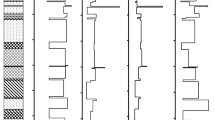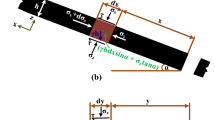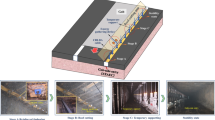Abstract
The stability of underground parallelepiped coal pillars formed during trunk road development in inclined coal seams is very important for safe access to the mine workings. These protective coal pillars developed around the trunk roads have the longest life span in coal mines. Although these pillars are designed with high safety factors, their failures continue to occur especially in inclined coal mines. The acute corners of parallelepiped coal pillars are highly stressed and prone to failure. These failures may be attributed to the deterministic safety factor which does not consider field geotechnical uncertainties in their design parameters. This research work identified the geotechnical uncertainties in pillar designs and incorporated them in designing stable pillars in inclined coal seams. A probabilistic approach based on limit state function has been proposed for designing stable parallelepiped coal pillars and validated in an inclined coal mine. In this study, the working stresses of the inclined coal pillars are varied for evaluating their influence on pillar reliability using the three cases of the limit state functions namely, empirical, numerical average, and numerical maximum. The pillar reliabilities were estimated by Monte Carlo Simulation. The results indicate that the empirical and numerical average cases yielded stable pillars, whereas the numerical maximum case provided an unstable design. The correlation between safety factor and reliability has been established which can predict the reliability for a given safety factor of pillars with a similar range of design inputs. Further, the threshold values of pillar sizes, acute corner angles, and seam gradients for the reliable pillar design have been determined by sensitivity analysis. These findings can help in designing stable parallelopiped pillars, especially in inclined coal seams to reduce pillar failures and enhance mine safety.
Highlights
-
Key geotechnical uncertainties in coal pillar stability parameters are identified
-
A limit state function-based probabilistic design approach is proposed to include geotechnical uncertainties.
-
The reliabilities of parallelepiped pillars in inclined coal seams are estimated using the Monte Carlo Simulation method.
-
The correlation between pillar reliability and the safety factor of parallelepiped coal pillars is established.
-
Threshold values of design parameters are determined for stable parallelepiped pillars using sensitivity analysis.


















Similar content being viewed by others
Data availability
Not applicable.
Abbreviations
- SF:
-
Safety factor
- \(S\) :
-
Strength of the flat pillar
- \({S}_{e}\) :
-
Strength of inclined pillar
- \({P}_{e}\) :
-
Resultant stress on inclined pillar
- \({\sigma }_{\mathrm{c}}\) :
-
Uniaxial compressive strength of coal sample of size 25 mm cube
- \({\sigma }_{\mathrm{n}}\) :
-
Normal stress on parallelepiped pillar
- \(\tau\) :
-
Shear stress on parallelepiped pillar
- \(h\) :
-
Pillar height
- \(H\) :
-
Depth of cover on pillars from the surface
- \({W}_{1}\),\({W}_{2}\) :
-
Shorter and longer widths of the pillar
- \({C}_{1}\) :
-
Length of the shorter side (\({W}_{1}+B)\)
- \({C}_{2}\) :
-
Length of the longer side (\({W}_{2}+B)\)
- \({w}_{\mathrm{e}}\) :
-
Effective width of the pillar
- \(B\) :
-
Gallery width
- \(\theta\) :
-
True dip
- \(\varphi\) :
-
Acute angles of the corners of inclined coal pillar
- \(k\) :
-
Ratio of major horizontal to vertical in situ stresses
- \(\gamma\) :
-
Unit weight of rockmass per meter of the depth of cover
- \(\mathrm{FP}\) :
-
Failure probability
- \(g\left(Z\right)\) :
-
Limit state function (LSF) for the inclined coal pillars
- (\({\mu }_{\mathrm{S}},{\mu }_{\mathrm{P}})\) :
-
Mean values of strength and stress
- (\({\sigma }_{\mathrm{S}},{\sigma }_{\mathrm{P}})\) :
-
Standard deviations of strength and stress
- \(R\) :
-
Pillar reliability
- \(\beta\) :
-
Reliability index
- MCS:
-
Monte Carlo simulation
- RQD:
-
Rock quality designation
- \({\sigma }_{\mathrm{cm}}\) :
-
Rockmass compressive strength
- \({\sigma }_{\mathrm{tm}}\) :
-
Rockmass tensile strength
- \({b}_{\mathrm{m}}\) :
-
Rockmass failure criterion exponent
- \({\tau }_{\mathrm{sm}}\) :
-
Rockmass shear strength
- \({\mu }_{0\mathrm{m}}\) :
-
Rockmass coefficient of internal friction
- \({\varphi }_{0\mathrm{m}}\) :
-
Rockmass angle of internal friction
- \(\rho\) :
-
Limit State Function
- \(TAM\) :
-
Tributary Area Method
- \(FORM\) :
-
First-Order Reliability Method
- \(FOSM\) :
-
First Order Second Moment
- \(PDF\) :
-
Probability Density Function
- \(LSF\) :
-
Limit State Function
- DHTT:
-
Dual height telltale
References
Bieniawski ZT (1992) A method revisited: coal pillar strength formula based on field investigations. In Proceedings of the workshop on coal pillar mechanics and design. Pittsburgh, PA: US Department of the Interior, Bureau of Mines, IC Vol. 9315. pp.158–165.
Brown ET (2012) Risk assessment and management in underground rock engineering—an overview. J Rock Mech Geotech Eng 4(3):193–204
Brown ET (2007) Block caving geomechanics, 2nd edn. Julius Kruttschnitt Mineral Research Centre (JKMRC), Indooroopilly., p 696
Cornell CA (1967) Bounds on the reliability of structural systems. J Struct Div 93(1):171–200
Carlisle S, Jung SJ (2006) Probabilistic Design of Hardrock Openings and Pillars. In Golden Rocks 2006, The 41st US Symposium on Rock Mechanics (USRMS). American Rock Mechanics Association.
Carter TG, Miller RI (1995) Crown-pillar risk assessment-planning aid for cost-effective mine closure remediation. Transactions of the Institution of Mining and Metallurgy-Section A-Mining Industry. pp. 104.
Cauvin M, Verdel T, Salmon R (2009) Modelling uncertainties in pillar stability analyses. Int J Risk Anal Risk Anal. 29(10):1371–1380
Coates DF (1973) Variance of pillar stresses at Elliot Lake. Int J Rock Mech Min Sci Geomech Abstr. 10(6):627–640
CSIR-CIMFR (2019) Design of workings, and support systems for developing trunk roads in Salarjung Seam along with Top Section and gate roads along with Bottom Section at Shantikhani mine, Mandamarri Area, SCCL.
Das AJ, Mandal PK, Paul PS, Sinha RK, Tewari S (2019a) Assessment of the strength of inclined coal pillars through numerical modelling based on the ubiquitous joint model. Rock Mech Rock Eng 52(10):3691–3717
Das AJ, Mandal PK, Paul PS, Sinha RK (2019b) Generalised analytical models for the strength of the inclined as well as the flat coal pillars using rock mass failure criterion. Rock Mech Rock Eng 52:3921–3946
Das AJ, Paul PS, Mandal PK, Kumar R, Tewari S (2021) Investigation of failure mechanism of inclined coal pillars: numerical modelling and tensorial statistical analysis with field validations. Rock Mech Rock Eng 54:3263–3289
DGMS, 2015. Statistics of mines in India (2001–2015). Volume-1, Directorate General of Mines Safety, Govt. of India, Dhanbad, India.
Dunn MJ (2019) Quantifying uncertainty in mining geomechanics design. In Proceedings of the First International Conference on Mining Geomechanical Risk, Australian Centre for Geomechanics. pp. 391–402.
Galvin JM (2016) Ground engineering principles and practices for underground coal mining. Springer International Publishing, Cham
Galvin JM, Hebblewhite BK, Salamon MD (1999) University of New South Wales coal pillar strength determinations for Australian and South African mining conditions. In Proceedings of the second international workshop on coal pillar mechanics and design, National Institute for Occupational Safety and Health, Report IC Vol. 9448. pp. 63-71
Ghasemi E, Shahriar K, Sharifzadeh M, Hashemolhosseini H (2010) Quantifying the uncertainty of pillar safety factor by Monte Carlo simulation-a case study. Arch Min Sci 55(3):623–635
Griffiths DV, Fenton GA, Lemons CB (2002) Probabilistic analysis of underground pillar stability. Int J Numer Anal Meth Geomech 26(8):775–791
Hadjigeorgiou J, Harrison JP (2011) Uncertainty and sources of error in rock engineering. In 12th ISRM Congress. International Society for Rock Mechanics and Rock Engineering. CRC Press, New York.
Hasofer AM, Lind NC (1974) Exact and invariant second-moment code format. J Eng Mech Div 100(1):111–121
ITASCA. Itasca Consulting Group, Inc., 2017, FLAC3D (Fast Lagrangian Analysis of Continua in 3 dimensions). Version 5.0. Minneapolis, USA.
Kalos MH, Whitlock PA (2009) Monte Carlo methods. John Wiley & Sons, New York
Kroese DP, Brereton T, Taimre T, Botev ZI (2014) Why the Monte Carlo method is so important today. Wiley Interdiscip Rev Comput Stat 6(6):386–392
Kumar R, Das AJ, Mandal PK, Bhattacharjee R, Tewari S (2021) Probabilistic stability analysis of failed and stable cases of coal pillars. Int J Rock Mech Min Sci 144:104810
Mark C (1992) Analysis of longwall pillar stability (ALPS); an update. Workshop on coal pillar mechanics and design, Santa fe, USBM, I.C.9315.238–249.
MATLAB and Statistics Toolbox R2016a (2016) The MathWorks, Inc., Natick, Massachusetts, USA.
Mohan GM, Sheorey PR, Kushwaha A (2001) Numerical estimation of pillar strength in coal mines. Int J Rock Mech Min Sci 38(8):1185–1192
Najafi M, Jalali SE, Bafghi AY, Sereshki F (2011) Prediction of the confidence interval for stability analysis of chain pillars in coal mines. Saf Sci 49(5):651–657
Najafi M, Jalali SME, Sereshki F, Bafghi AY (2016) Probabilistic analysis of stability of chain pillars in Tabas coal mine in Iran using Monte Carlo simulation. J Min Environ 7(1):25–35
Nikitin O (2003) Mining block stability prediction by the Monte Carlo method. 4th International Conference. Environ Technol Resour. 1:185–190
Peng SS, Chiang HS (1984) Longwall mining. Wiley, New York
Phoon KK (2017) Role of reliability calculations in geotechnical design. Georisk Assess Manag Risk Eng Syst Geohazards. 11(1):4–21
Pine RJ (1992) Risk analysis design applications in mining geomechanics. Trans Inst Min Metall Sect A Min Ind. 101:149–158
Pytel WM (1990) Reliability level III method in design of square pillar resting on weak floor stratum. Int J Min Geol Eng 8(2):149–162
Salamon MDG, Munro AH (1967) A study of the strength of coal pillars. J South Afr Inst Min Metall 68(2):55–67
Song G, Yang S (2018) Probability and reliability analysis of pillar stability in South Africa. Int J Min Sci Technol 28(4):715–719
Salamon MDG, Canbulat I, Ryder JA (2006) Seam-specific pillar strength formulae for South African collieries. In Proceedings of the 50th US Rock Mechanics Symposium, Golden CO, Paper. pp.1106–1154.
Salamon MDG, Galvin JM, Hocking G, Anderson I (1996) Coal pillar strength from back-calculation. Research report no. 1/96. Department of Mining Engineering, University of New South Wales, Sydney, p 62
Sheorey PR (1997) Empirical rock failure criteria. Balkema, Rotterdam
Sheorey PR, Das MN, Barat D, Prasad RK, Singh B (1987) Coal pillar strength estimation from failed and stable cases. Int J Rock Mech Min Sci Geomech Abstr. 24(6):347–355
Sheorey PR (1992) Pillar strength considering in situ stresses. In: Iannacchione AT, et al. (eds) Proceedings of the Workshop on Coal Pillar Mechanics and Design, USBM IC 9315. pp. 122–7.
Trumbachev, V.F., and Melnikov, E.A., 1964. Distribution of stresses in the intervening pillars at medium and steep dips. In 4th Conference on strata control and rock mechanics, New York, pp. 316–322.
Van der Merwe JN (2019) Coal pillar strength analysis based on size at the time of failure. J South Afr Inst Min Metall 119(7):681–692
Van der Merwe JN, Mathey M (2013) Probability of failure of South African coal pillars. J South Afr Inst Min Metall 113(11):849–857
Wagner H (1974) Determination of the complete load-deformation characteristics of coal pillars. In Proceedings of the third international congress on rock mechanics. National Academy of Sciences. pp 1076–1081
Wilson AH (1982) Pillar stability in longwall mining State-of-the-art of ground control in longwall mining and mining subsidence. SME, New York, pp 85–95
Yu Y, Chen SE, Deng KZ, Fan HD (2017) Long-term stability evaluation and pillar design criterion for room-and-pillar mines. Energies 10(10):1644
Acknowledgements
The authors are thankful to the Director, CSIR-Central Institute of Mining and Fuel Research Dhanbad for permitting this research work for publication. The views expressed in this paper are that of the authors and not necessarily of the organization to which they belong.
Funding
This work was supported by the Council of Scientific and Industrial Research (CSIR), New Delhi under the Niche Creating Projects (NCP) category [grant number: MLP-144, 2020-21].
Author information
Authors and Affiliations
Corresponding author
Ethics declarations
Conflict of Interest
The authors declare that they have no conflict of interest.
Additional information
Publisher's Note
Springer Nature remains neutral with regard to jurisdictional claims in published maps and institutional affiliations.
Rights and permissions
Springer Nature or its licensor (e.g. a society or other partner) holds exclusive rights to this article under a publishing agreement with the author(s) or other rightsholder(s); author self-archiving of the accepted manuscript version of this article is solely governed by the terms of such publishing agreement and applicable law.
About this article
Cite this article
Kumar, R., Mandal, P.K., Ghosh, N. et al. Design of Stable Parallelepiped Coal Pillars Considering Geotechnical Uncertainties. Rock Mech Rock Eng 56, 6581–6602 (2023). https://doi.org/10.1007/s00603-023-03415-y
Received:
Accepted:
Published:
Issue Date:
DOI: https://doi.org/10.1007/s00603-023-03415-y




